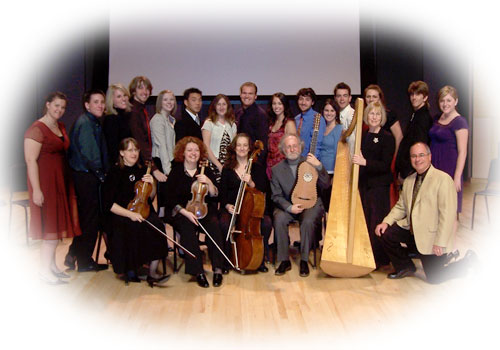Early Music Ensemble at UC Riverside
 The Cal Poly Early Music Ensemble recently presented a pair of concerts titled “Music of the California Missions: a Tapestry of Sounds.” With Thomas Davies conducting and Craig Russell serving as the musicologist, adviser, and baroque guitarist, they played the program first in the Pavilion of the Performing Arts Center before a packed house on Feb. 24. Then, upon the invitation of the University of California at Riverside, they repeated the program the next weekend as the culminating event of UCR’s festival, “Encounters/Encuentros: Music and Musicians of the California Missions.” At the event, Russell was a featured speaker, presenting “Musical Style and Performance in California Mission Life.” The program had several highlights, including a performance of the “Credo Artanense” and “Misa del quarto tono” that had been staples in the California missions but had not been heard for hundreds of years. All of the music—except for one piece—had been reconstructed from the original manuscripts in California archives and the Mexico City Cathedral by Russell. The one piece not transcribed by Russell was Manuel de Sumaya’s “En María la gracia” (1728). This glorious work was reconstructed by one of our students, Jeremy “Spud” Schroeder, as part of his senior project. He took photos of this church piece, interpreting the old mensural notation and transcribing it into modern notation so that the Early Music Ensemble could perform it. This work had not been heard in over two centuries! The piece was full of clever and tricky rhythms, all of which were performed splendidly by the members of Early Music Ensemble, as if they had grown up in 18th-century Mexico or California. Nearly every one of our students in this prestigious group had prominent solo passages, and we can be proud of the level of artistic performance that they achieved in this program. In addition, our faculty harpist, Jennifer Sayre, played all the accompaniments on her baroque harp (arpa de dos órdenes). She is known internationally as the basso continuo player on baroque harp (that is, the best harpist who has the skill of improvising an accompaniment at sight merely by looking at the cello line).
The Cal Poly Early Music Ensemble recently presented a pair of concerts titled “Music of the California Missions: a Tapestry of Sounds.” With Thomas Davies conducting and Craig Russell serving as the musicologist, adviser, and baroque guitarist, they played the program first in the Pavilion of the Performing Arts Center before a packed house on Feb. 24. Then, upon the invitation of the University of California at Riverside, they repeated the program the next weekend as the culminating event of UCR’s festival, “Encounters/Encuentros: Music and Musicians of the California Missions.” At the event, Russell was a featured speaker, presenting “Musical Style and Performance in California Mission Life.” The program had several highlights, including a performance of the “Credo Artanense” and “Misa del quarto tono” that had been staples in the California missions but had not been heard for hundreds of years. All of the music—except for one piece—had been reconstructed from the original manuscripts in California archives and the Mexico City Cathedral by Russell. The one piece not transcribed by Russell was Manuel de Sumaya’s “En María la gracia” (1728). This glorious work was reconstructed by one of our students, Jeremy “Spud” Schroeder, as part of his senior project. He took photos of this church piece, interpreting the old mensural notation and transcribing it into modern notation so that the Early Music Ensemble could perform it. This work had not been heard in over two centuries! The piece was full of clever and tricky rhythms, all of which were performed splendidly by the members of Early Music Ensemble, as if they had grown up in 18th-century Mexico or California. Nearly every one of our students in this prestigious group had prominent solo passages, and we can be proud of the level of artistic performance that they achieved in this program. In addition, our faculty harpist, Jennifer Sayre, played all the accompaniments on her baroque harp (arpa de dos órdenes). She is known internationally as the basso continuo player on baroque harp (that is, the best harpist who has the skill of improvising an accompaniment at sight merely by looking at the cello line).

